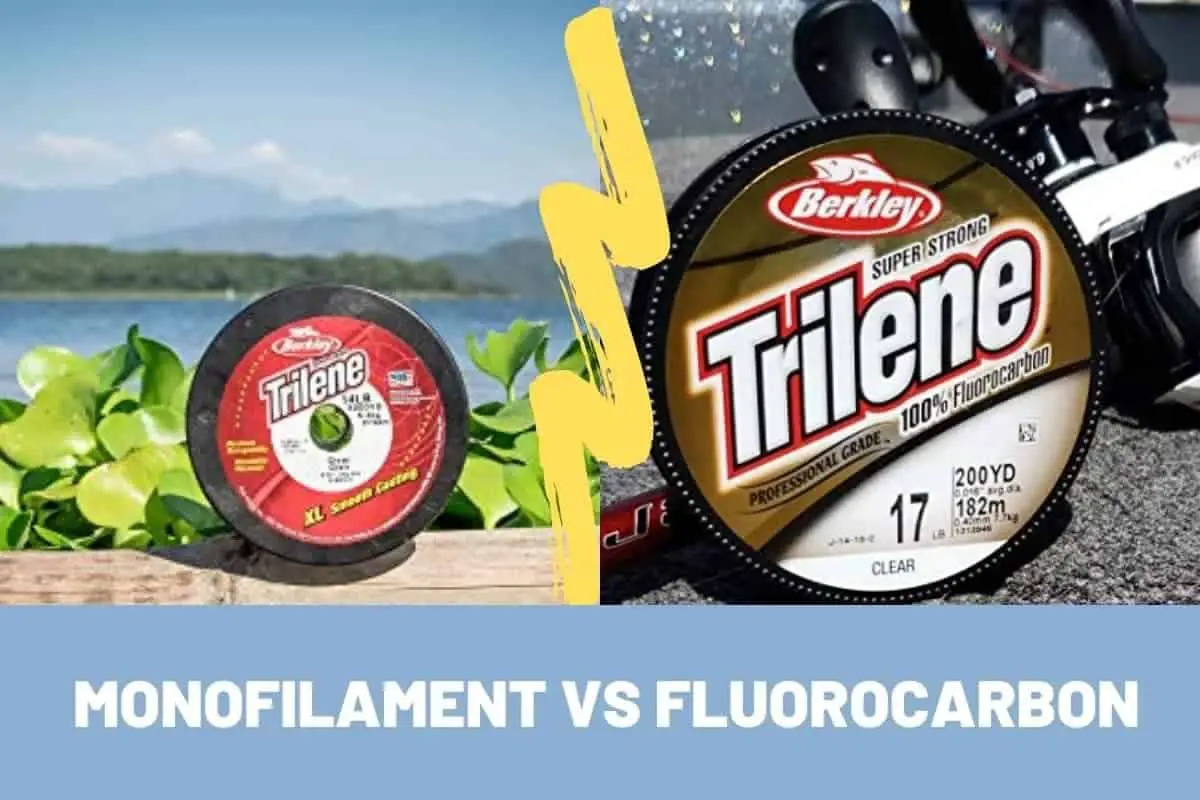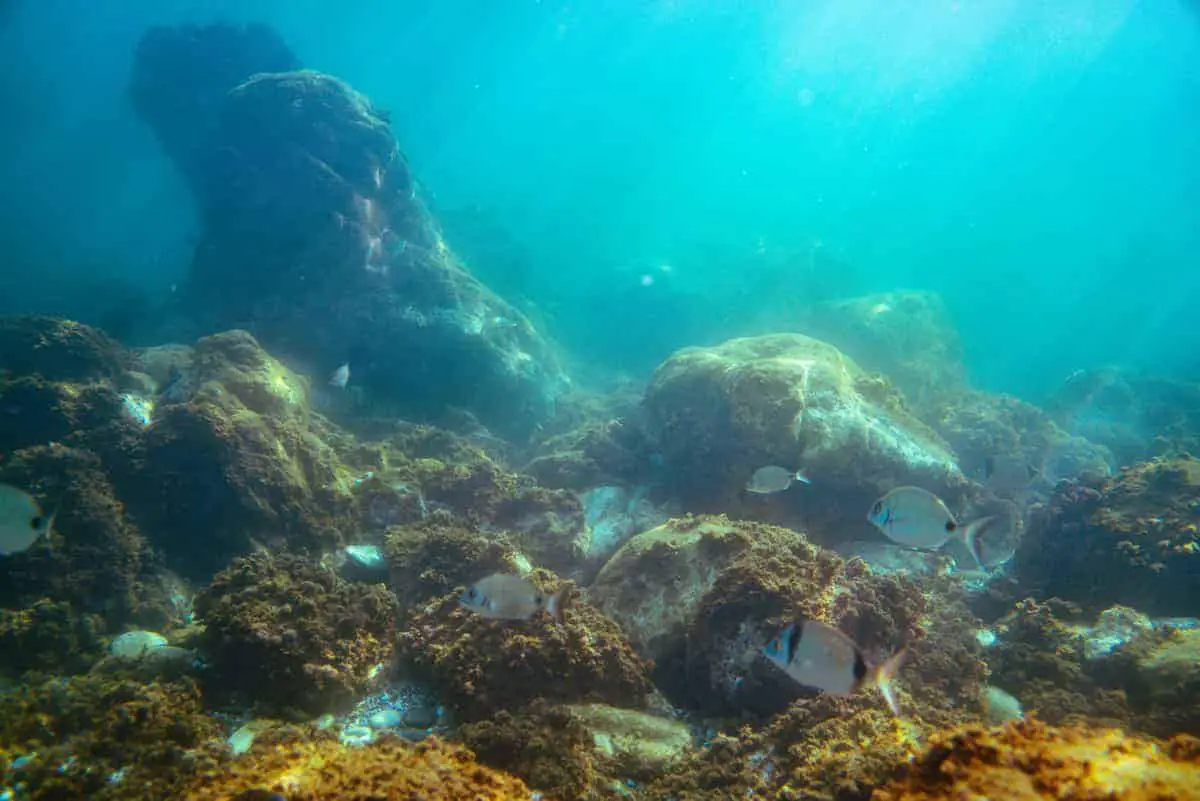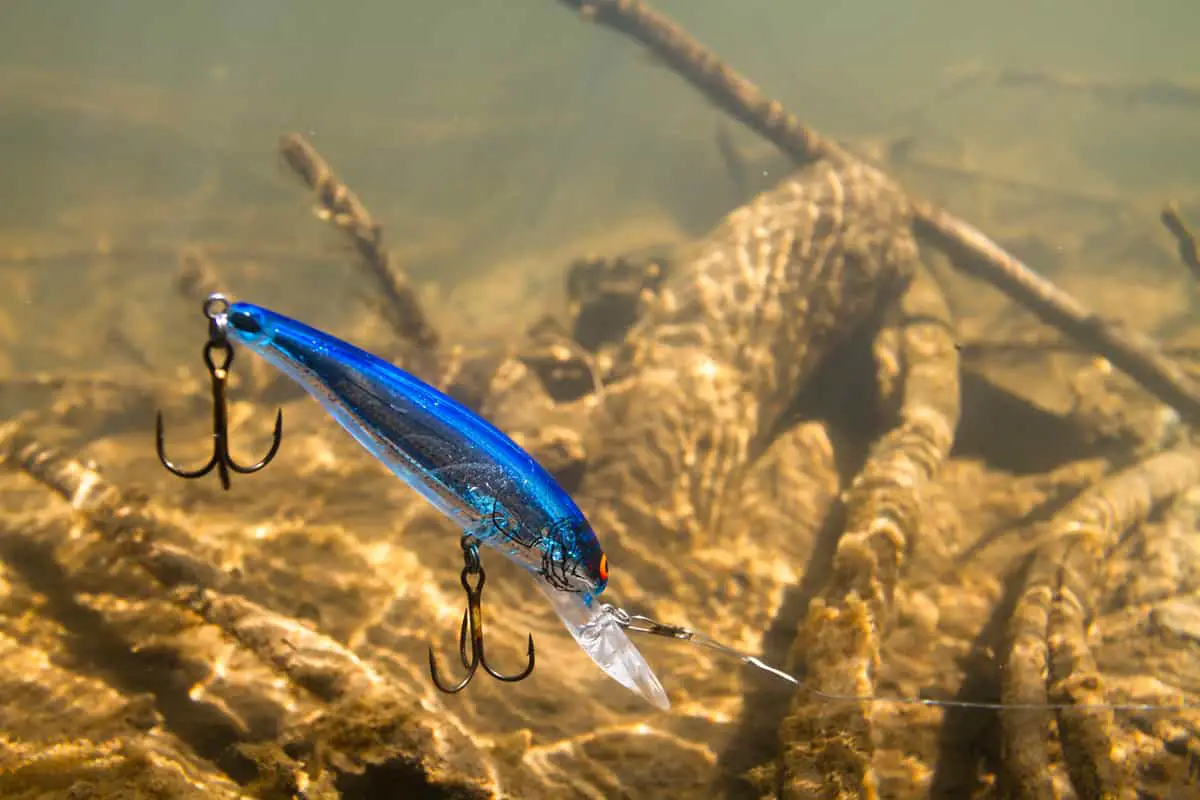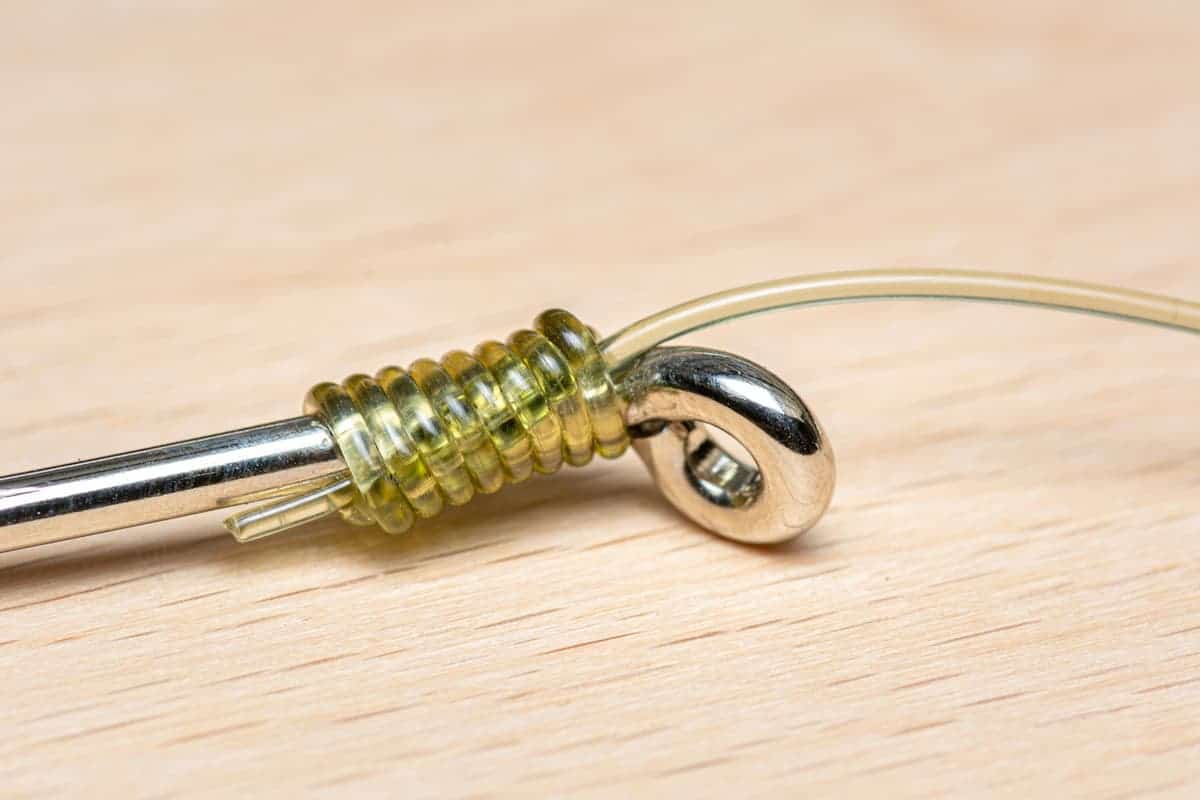
Anglers will need to make many informative decisions to have a successful day of fishing. One of the most significant decisions that need to be made is picking the correct type of fishing line to use.
This is why we will be putting monofilament and fluorocarbon fishing lines against each other in a head-to-head battle in this post.
We’ll leave no stone unturned and cover as much information as possible. Here are the main topics we will talk about:
- Strength / Line Diameter
- Performance
- Casting
- Knotability
- Main Line Usage
- Leader Line Usage
- Life Span
- Price
- Recycability
Summary Table:
| Line Properties | Monofilament | Fluorocarbon |
|---|---|---|
| Line Strength | – | Slightly Stronger |
| Line Diameter | Thicker | Slightly Thinner |
| Abrasion Resistance | Least Abrasion Resistance | More Abrasion Resistance |
| Line Stretch | Stretches Uniformly With Load ~ 10% – 25% Stretch | Stretches at 50% of Line Rating ~ 10% – 25% Stretch |
| Line Buoyancy | Sinks Slowly | Sinks Fast |
| Line Memory | Low | High |
| Line Visibility | High | Low |
| Casting | Best | Not Recommended |
| Knotability | Easier | Harder |
| Mainline usage | Best | Not Recommended |
| Leader Line Usage | Decent – Depending On Situation | Best – Depending On Situation |
| Life Span | 1 – 2 Years | 1 – 5 Years |
| Recyclability | Yes | Yes |
Strength / Line Diameter – Monofilament Vs Fluorocarbon
A fishing line’s strength refers to how much weight the line can hold and is designated by its line rating, found on the packaging.
When comparing different line ratings, it’s only comparing the line’s absolute strength. This means a mono and fluoro line, both rated for 20 lb, can hold 20 lbs of weight before breaking.
The line rating is an excellent metric when comparing strength, but it doesn’t give you the whole picture when you’re looking for the “strongest line.”
The strongest fishing line can hold a particular weight while having the thinnest line diameter possible. This is also known as “line load capacity” measured in psi.
Line Diameter – Monofilament Vs Fluorocarbon
The line diameter is determined by the strength of the material the line is made from.
If a fishing line was made from a weak material, the line would need more material to hold 20 lb. Hence, a larger line diameter.
Whereas, if a fishing line was made from a strong material, the line would need less material to hold the same 20 lb. Hence, a smaller line diameter.
Let’s compare the monofilament and fluorocarbon line diameters from Berkley.
| Trilene Big Game Monofilament – 20 lb Rating | Trilene Fluorocarbon – 20 lb Rating |
|---|---|
| Line Diameter: 0.018in (0.45mm) | Line Diameter: 0.017in (0.43mm) |
The line diameters are only 0.001in (0.02mm) difference.
This might seem pretty negligible, but this slight difference can significantly impact how much line your reel can hold and the line’s load capacity.
Line Load Capacity – Monofilament Vs Fluorocarbon
Load capacity is a great way to measure the fishing line’s material strength.
Continuing with our example above, let’s look at the calculated load capacity.
| Trilene Big Game Monofilament – 20 lb Rating | Trilene Fluorocarbon – 20 lb Rating |
|---|---|
| Line Diameter: 0.018in (0.45mm) | Line Diameter: 0.017in (0.43mm) |
| Load Capacity: 78,595 psi | Load Capacity: 88,133 psi |
Fluorocarbon is the winner!
Fluoro is truly a stronger line with a load capacity of 9,538 psi, more than mono.
Performace – Monofilament Vs Fluorocarbon
How your fishing line performs in the water is critical.
Various performance characteristics can come into play, deciding whether you catch fish or not.
Here are the performance characteristics we’ll look at when comparing mono and fluoro lines.
- Abrasion Resistance
- Stretch
- Buoyancy
- Line Memory
- Visibility

Abrasion Resistance – Monofilament Vs Fluorocarbon
Monofilament is made from nylon, and fluorocarbon is made from PVDF.
Nylon and PVDF are different types of plastic with varying properties. When it comes to abrasion resistance, one crucial material property is the material’s hardness.
Material hardness can be described as the amount of force it takes to scratch the surface.
For example, steel is harder to scratch than a block of wood.
PVDF is a harder and denser material than nylon. Making fluorocarbon fishing lines naturally more abrasion-resistant than mono.
That being said, monofilament is used in many different applications where abrasion resistance is needed.
Monofilament can have different chemicals and resins added to it when manufactured, making the line more abrasion-resistant.
You should not decide on what fishing line to use solely based on abrasion resistance. That is why we have leader lines!
But for this case, fluorocarbon wins the battle for most abrasion-resistant.
Line Stretch – Monofilament Vs Fluorocarbon
There are many misconceptions regarding line stretch between monofilament and fluorocarbon lines.
It’s common knowledge among many anglers that monofilament lines will stretch.
The misconception is with fluorocarbon lines. Many online resources say that fluorocarbon lines don’t stretch.
This is wrong!
Fluorocarbon lines can stretch about the same amount as mono. But it takes more force to make it stretch than mono.
Both mono and fluoro will be able to stretch anywhere between 10% – 25% of their length.
But mono is very sensitive to loads and will start stretching right away. Fluoro is not as sensitive to loads and will start stretching roughly around 50% of its line rating.
Mono provides an even and predictable stretch which is why this line is so popular when trolling or when you need a shock-absorbing effect from hard striking fish.
Fluoro is a good blend between a line that does stretch and one that doesn’t. Fluoro would be great to use when bottom fishing in deep waters.
Monofilament is more predictable in its stretch, making it easier to manage. Monofilament is the winner here.
Line Buoyancy – Monofilament Vs Fluorocarbon
Knowing if your fishing line will float or sink should be vital to you as an angler as it plays a significant role in bait presentation.
Using a fishing line that sinks when you’re fishing topwater will cause you problems because you will never be where the fish are.
And the reverse is also true. Using a line that floats where you’re bottom fishing may cause issues.
To determine if your fishing line will sink or float is dependent on how buoyant your line is.
The two factors that determine how buoyant your line is:
- Line Density
- Line Diameter
But the primary factor to consider is the line density. If the line density is heavier than the density of water, the line will sink.
If the line density is lighter than the density of water, the line will float.
| Monofilament | Fluorocarbon | Freshwater | Saltwater | |
|---|---|---|---|---|
| Density | 0.0415 lb/in^3 (1.15 g/cm^3) | 0.0630 lb/in^3 (1.78 g/cm^3) | 0.036 lb/in^3 (1.0 g/cm^3) | 0.037 lb/in^3 (1.25 g/cm^3) |
Monofilament:
- 15% heavier than freshwater
- 12% heavier than saltwater
Fluorocarbon:
- 78% heavier than freshwater
- 74% heavier than saltwater
Both lines will sink in water. But, fluorocarbon will sink faster than monofilament.
If you need your bait to remain at the bottom, you’ll want to use fluorocarbon.
However, if you need your bait to remain at the upper portion of the water column, you would be best served using mono.
Even though mono sinks, the sinking rate is much slower, allowing for a slower and controlled descent that can help you provide the proper action you need.
Line Memory – Monofilament Vs Fluorocarbon
The notorious line memory has haunted anglers for many years. Dealing with a fishing line with a lot of memory can be a huge pain.
Line memory is dependent on two factors:
- Fishing Line Material
- Fishing Line Diameter
Mono is created from nylon, a soft and flexible type of plastic. The amount of line memory that monofilament contains is pretty low.
This is why so many anglers love using monofilament as their mainline.
Of course, as you move up to the stronger monofilament lines like 40lb+, the line memory increases and becomes more noticeable.
Fluoro is created from PVDF, a hard and stiff type of plastic. The amount of line memory that fluorocarbon contains is the highest among all the different fishing lines in the market.
There have been many different advancements in reducing fluorocarbon’s memory, and it has become more useable now than ever before.
That being said, monofilament still has the least amount of line memory between these two lines.

Visibility – Monofilament Vs Fluorocarbon
Line visibility plays a significant role in your bait presentation.
If fish can easily detect your fishing line, it may prevent an overly cautious fish from striking.
If that same fish can’t detect your fishing line, it might make the fish want to take the bait.
So what determines how visible a fishing line is underwater?
Two words – Light Refraction!
Light refraction is a term in physics that describes how light waves pass through an object or if the light waves change direction as it passes through multiple objects.
In our case, light waves will pass through the water first and then pass through the fishing line.
The closer the refraction index of a material is to that of water means the light will pass through the material like if it were water.
This makes the object practically invisible underwater.
Fluorocarbon has a light refraction index closest to water, making the fishing line invisible underwater.
Most fluorocarbon lines in the market are clear because there is no need to play around with the colours.
Monofilament is noticeable underwater until you get into deep waters where the light can barely reach. Until you reach these depths, you will need to investigate which line colours will work best for you to reduce line visibility as much as possible.
Casting – Monofilament Vs. Fluorocarbon
Being able to cast a fishing line is a fundamental skill that any angler will need to master. But not all fishing lines are optimum for casting.
Monofilament is considered to be a pretty good casting line.
The low line memory prevents the line from backlashing and tangling during casting. It also helps with improving your casting distance.
Even though you can cast with fluorocarbon lines, it’s generally not recommended.
There are fluorocarbon lines that are advertised as casting lines, but why?
You would be better served if you used a mono as your mainline for casting and attached a fluoro leader on the bait end if you need a fluorocarbon line.

Knotability – Monofilament Vs Fluorocarbon
Knotability describes how easy it is to make a knot with a particular fishing line.
Since monofilament lines are flexible, it is easy for anglers to make knots and hold them.
Fluorocarbon is stiffer and not as flexible as mono. This makes it harder to get good strong knots.
Not to mention, knots made from fluorocarbon lines have a tendency to become undone over time because of the stiffness.
If you are an absolute beginner, stick with monofilament lines until you can nail down your knots.
Main Line Usage – Monofilament Vs. Fluorocarbon
Picking the right fishing line for a mainline is critical to your fishing success.
If you pick the wrong fishing line, you might find it harder to feel bites, get a good hookset, or can potentially damage your fishing rod.
Mono and fluoro share many similarities, but their differences can make an angler go in one direction versus another.
Monofilament fishing lines are a great choice if you are fishing:
- Fishing topwater
- Casting
- Trolling
- Fishing with Live-Bait
- Near Underwater Structure
Fluorocarbon fishing lines are a great choice if you are fishing:
- Trolling
- Near underwater structure
- Trolling
Due to fluoro’s line memory issues, it would be best to use mono as a mainline instead. It’s definitely doable to use fluoro as a mainline, but it might not be optimal.
Leader Line Usage – Monofilament Vs. Fluorocarbon
Monofilament lines have been used as a leader line for many years and still are today.
Fluorocarbon lines have been improved to make up for mono’s shortcomings as a leader line.
Fluorocarbon leaders have good abrasion resistance and are less likely to break if they encounter sharp underwater obstructions.
Combining that with fluorocarbon visibility and stretch for hard-hitting fish makes fluoro leaders the best choice for many different applications.
Monofilament leaders are great when you want your bait to gently sink down the water column and are not concerned about line visibility.
These leaders still provide decent abrasion resistance if you’re fishing about underwater structures.
In my humble opinion, fluorocarbon would be the best choice for a leader line about 90% of the time. Unless you are fishing a lot of topwater, use a monofilament leader.
Life Span – Monofilament Vs. Fluorocarbon
The life span of a fishing line will determine how often you should be replacing your fishing line.
A fishing line’s life span depends on a wide range of parameters. Generally speaking, here is a rough estimate of when you should be replacing your line.
- Monofilament Life Span: 1 – 2 years
- Fluorocarbon Life Span: 1 – 5 years
Price – Monofilament Vs. Fluorocarbon
Regardless of how good a line is compared to another, we’ll pay for whatever line we can comfortably afford at the end of the day.
Monofilament fishing lines are considered the cheapest fishing line you can buy.
Thanks to the material and modern manufacturing processes, these lines can be cheaply manufactured, giving anglers a great deal at the counter.
Fluorocarbon fishing lines are considered to be expensive to purchase.
The manufacturing process for fluoro is similar to mono, but it’s the material that makes fluorocarbon lines expensive.
Recyclability – Monofilament Vs. Fluorocarbon
Both monofilament and fluorocarbon are made from manmade plastics.
These plastics do not easily break down in the environment. In fact, it can take about 600 years before these fishing lines can break down in the environment.
But the good news is that both of these fishing lines are recyclable.
Some of the largest fishing line producers like Berkley participate in a massive recycling program to help anglers dispose of their old fishing lines.
Happy Fishing & Tight Lines
